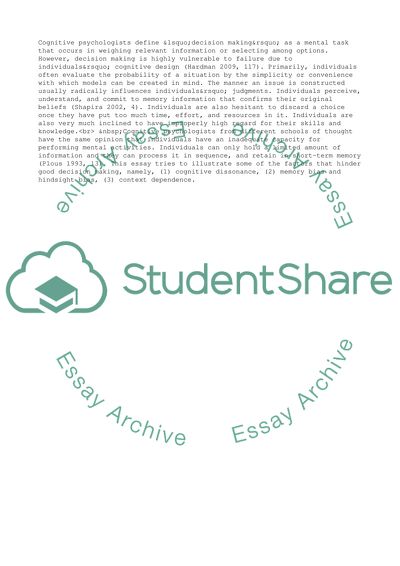Cite this document
(“Decision Making and Rationality in the Modern World Essay”, n.d.)
Decision Making and Rationality in the Modern World Essay. Retrieved from https://studentshare.org/management/1600032-explore-and-analyse-the-nature-of-perception-cognitive-dissonance-memory-and-context-dependence-in-relation-firstly-to-twelve-angry-men-url-below-students-must-then-apply-this-analysis-to-the-demise-of-enron-focusing-on-which-of-these-psychological
Decision Making and Rationality in the Modern World Essay. Retrieved from https://studentshare.org/management/1600032-explore-and-analyse-the-nature-of-perception-cognitive-dissonance-memory-and-context-dependence-in-relation-firstly-to-twelve-angry-men-url-below-students-must-then-apply-this-analysis-to-the-demise-of-enron-focusing-on-which-of-these-psychological
(Decision Making and Rationality in the Modern World Essay)
Decision Making and Rationality in the Modern World Essay. https://studentshare.org/management/1600032-explore-and-analyse-the-nature-of-perception-cognitive-dissonance-memory-and-context-dependence-in-relation-firstly-to-twelve-angry-men-url-below-students-must-then-apply-this-analysis-to-the-demise-of-enron-focusing-on-which-of-these-psychological.
Decision Making and Rationality in the Modern World Essay. https://studentshare.org/management/1600032-explore-and-analyse-the-nature-of-perception-cognitive-dissonance-memory-and-context-dependence-in-relation-firstly-to-twelve-angry-men-url-below-students-must-then-apply-this-analysis-to-the-demise-of-enron-focusing-on-which-of-these-psychological.
“Decision Making and Rationality in the Modern World Essay”, n.d. https://studentshare.org/management/1600032-explore-and-analyse-the-nature-of-perception-cognitive-dissonance-memory-and-context-dependence-in-relation-firstly-to-twelve-angry-men-url-below-students-must-then-apply-this-analysis-to-the-demise-of-enron-focusing-on-which-of-these-psychological.


